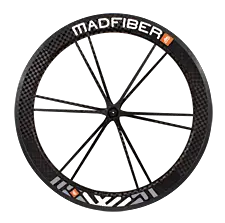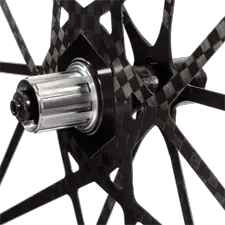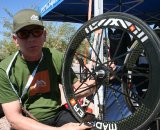Mad Fiber makes some impressively light carbon wheels which we’ve had great success with in testing in both cyclocross and road environments. Their carbon spoked and carbon rim tubular wheels are the lightest test wheels we’ve ridden, and have withstood some hard hits and botched remounts. Mad Fiber now has increased the level of scrutiny in puts on its wheels, to validate their strength and ensure quality control. That should be good news to anyone needing assurance that their nearly full-carbon wheels will withstand the rigors of cyclocross. Full press release and video below.
May 20, Seattle, WA — When you build a bicycle wheel business that not only recognizes the potential of carbon fiber to deliver increased performance and strength at lower weights but that is predicated on actually realizing this potential, it only makes sense that you simultaneously recognize the opportunity and need to raise the bar on development and quality control testing standards and protocols.
Simply, because of it’s nearly infinite fatigue life and it’s structural properties, carbon can and should be pushed farther and harder than any other material. And it can be tested on a unit-by-unit basis when appropriate, rather than relying on the nth-sample testing protocols developed for metal production.
While known for building some of the lightest wheels on the market (1080g/pair tubulars, 1250g/pair clinchers), Mad Fiber is also committed to developing wheels that are among the strongest. In this pursuit, Mad Fiber has implemented a battery of tests – some used in the development process, others used for each wheel that comes off the assembly line.
Testing includes everything from UCI crash testing (which both clinchers and tubulars pass), brake heat protocols exceeding 400°f, bearing load tests, radial and lateral stiffness measurements, trueness and spoke tension verification and many more – but most noteworthy is the radical adaptation of the industry-standard fatigue test. For many years, the benchmark has been to test wheels by placing them on a cleated, rolling drum which simulates impacts to the wheel. The wheel is loaded radially with 130lbs, and run at 20mph for 1000miles, receiving an impact every 18in. The Mad Fiber adaptation of this test adds the following dynamics:
1 ) radial load is increased from 130 to 200lbs – the approximate equivalent of having an 400lb rider on the bike.
2 ) a side load of 100lbs is simultaneously introduced at one point on the wheel. This is equivalent to a rider of 300lbs leaning the bike at a 30° angle in a track stand. These loads, individually, are likely far more than a wheel would ever see in actual use. The two loads together are all but impossible to produce in real-world conditions.
3 ) the cleated drum, 20mph speed and test duration remain the same for the fatigue test, which an nth sample of Mad Fiber wheels must pass throughout production.
4 ) perhaps more importantly, every wheel is tested to this standard over a shorter distance/period of time as a way of verifying bond integrity and other elements of the wheel construction. This test has been in place since the beginning of 2013, and ensures that all wheels coming off the assembly line are structurally exceptional, and problem free.
The video below highlights Mad Fiber’s wheel testing.
For more info:

























